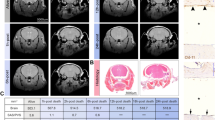Summary
This study uses a recently developed technique for preserving the ultrastructure of cells in the insect CNS during immunohistochemical processing for 5-bromo-2-deoxyuridine incorporation into newly synthesised DNA. The results allow us to identify the proliferating cell calsses in the regenerating blood-brain barrier. High resistance barrier cells do not label with the antibody but sheath cells clearly do. Intermediate cell types appearing during repair are identified. It is hypothesised that these cells generate matrix molecules for neural lamella repair and may represent transitional forms as invasive blood cells transdifferentiate into functional sheath cells.
Similar content being viewed by others
References
Abbott NJ, Treherne JE (1977) Homeostasis of the brain microen-vironment: a comparative account. In: Gupta BL, Moreton RB, Oschman JL, Wall BJ (eds) Transport of ions and water in animals. Academic Press, London New York, pp 481–510
Ashhurst DE (1965) The connective tissue sheath of the locust nervous system: its development in the embryo. Q J Microsc Sci 102:61–73
Ashhurst D (1979) Hemocytes and connective tissue. In: Gupta AP (ed) Insect hemocytes. Cambridge University Press, Cambridge, pp 319–330
Edwards JS, Swales LS, Bate CM (1990) Absence of perineurial sheath and associated cells in twist, a mesodermless mutant of Drosophila melanogaster. Soc Neurosci Abstr 16:1272
Howes EA, Chain BM, Smith PJS, Treherne JE (1987a) Blood cells contribute to glial repair in an insect. Tissue Cell 19:877–879
Howes EA, Smith PJS, Treherne JE (1987b) Glial repair in the cultured central nervous system of an insect. Cell Tissue Res 247:111–120
Lackie AM (1988) Haemocyte behaviour. Adv Insect Physiol 21:85–178
Maddrell SHP, Treherne JE (1967) The ultrastructure of the perineurium in two insect species, Carausius morosus and Periplaneta americana. J Cell Sci 2:119–128
Scharrer BCJ (1939) The differentiation between neuroglia and connective tissue sheath in the cockroach (Periplaneta americana). J Comp Neurol 70:77–88
Scharrer BCJ (1972) Cytophysiological features of haemocytes in cockroaches. Z Zellforsch 129:241–248
Schofield PK, Treherne JE (1984) Localization of the blood-brain barrier of an insect: electrical model and analysis. J Exp Biol 109:319–331
Schofield PK, Swales LS, Treherne JE (1984) Potentials associated with the blood-brain barrier of an insect: recordings from identified neuroglia. J Exp Biol 109:307–318
Shepherd D, Bate CM (1990) Spatial and temporal patterns of neurogenesis in the embryo of the locust (Schistocerca gregaria). Development 108:83–96
Smith PJS, Howes EA (1984) Glial toxin effect on protein synthesis in an insect connective. J Cell Sci 70:83–92
Smith PJS, Howes EA (1987) Neural repair in an insect central nervous system: cell kinetics and proliferation after selective glial disruption. Cell Tissue Res 247:129–135
Smith PJS, Leech CA, Treherne JE (1984) Glial repair in an insect central nervous system: effects of selective glial disruption. J Neurosci 4:2698–2711
Smith PJS, Howes EA, Leech CA, Treherne JE (1986) Haemocyte involvement in the repair of the insect central nervous system after selective glial disruption. Cell Tissue Res 243:367–374
Smith PJS, Howes EA, Treherne JE (1987) Mechanisms of glial regeneration in an insect central nervous system. J Exp Biol 132:59–78
Smith PJS, Howes EA, Treherne JE (1990) Cell proliferation in the repairing adult insect central nervous system: incorporation of the thymidine analogue 5-bromo-2-deoxyuridine in vivo. J Cell Sci 95:599–604
Smith PJS, Shepherd D, Edwards JS (1991) Neural repair and glial proliferation: parallels with gliogenesis in insects. Bioessays 13:65–72
Swales LS, Smith PJS (1990) Immunohistochemical localisation of the thymidine anlogue 5-bromo-2-deoxyuridine in insect tissue: preservation of cellular ultrastructure. Tissue Cell 22:311–317
Treherne JE, Smith PJS, Edwards H (1987) Neural repair in an insect: cell recruitment and deployment following selective glial disruption. Cell Tissue Res 247:121–128
Treherne JE, Smith PJS, Howes EA (1988a) Neural repair and regeneration in insects. Adv Insect Physiol 21:35–84
Treherne JE, Smith PJS, Howes EA (1988b) Cell recruitment during glial repair: the role of exogenous cells. Cell Tissue Res 251:339–343
Wigglesworth VB (1979) Haemocytes and growth in insects. In: Gupta AP (ed) Insect Hemocytes. Cambridge University Press, Cambridge, pp 303–318
Author information
Authors and Affiliations
Rights and permissions
About this article
Cite this article
Swales, L.S., Howes, E.A. & Smith, P.J.S. Cell specific DNA-labelling in the repairing blood-brain barrier of the insect Periplaneta americana . Cell Tissue Res 267, 535–543 (1992). https://doi.org/10.1007/BF00319376
Received:
Accepted:
Issue Date:
DOI: https://doi.org/10.1007/BF00319376




